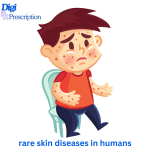
Rare skin diseases, though uncommon, can significantly impact individuals' quality of life. Understanding these conditions is crucial for early diagnosis and appropriate management. Here are some notable rare skin diseases:
1. Epidermolysis Bullosa (EB)
EB is a group of genetic disorders characterized by extremely fragile skin that blisters and tears easily, often referred to as "butterfly skin." Blisters can occur in response to minor injuries, heat, or friction from rubbing or scratching. In severe cases, blisters may also develop on internal linings, such as the mouth or intestines. There is no cure for EB; treatment focuses on wound care, pain management, and preventing complications.
NIAMS.NIH.GOV
2. Harlequin Ichthyosis
This severe genetic disorder affects the skin's ability to act as a barrier. Infants are born with thick, hard skin covering most of their bodies, forming large diamond-shaped plates separated by deep cracks. These skin abnormalities can affect facial features and restrict movement. Advances in neonatal care have improved survival rates, but ongoing treatment is necessary to manage the condition.
HEALTHLINE
3. Erythropoietic Protoporphyria (EPP)
EPP is a form of porphyria that causes severe pain upon exposure to sunlight. Individuals with EPP may experience swelling, burning, and redness of the skin after even brief sun exposure. Chronic cases can lead to liver complications. Management includes strict avoidance of sunlight and protective measures to minimize exposure.
VERYWELLHEALTH.COM
4. Blau Syndrome
A rare autoinflammatory disorder that typically presents in early childhood, Blau syndrome is characterized by a triad of symptoms: granulomatous dermatitis (skin inflammation), arthritis, and uveitis (eye inflammation). It results from mutations in the NOD2 gene.
MEDICALNEWSTODAY.COM
5. Chromhidrosis
This rare condition causes colored sweat, typically yellow, green, blue, or black. It results from the secretion of lipofuscin, a pigment, in the sweat glands. While not harmful, chromhidrosis can cause significant distress due to its visible nature. Treatment options include topical capsaicin cream and botulinum toxin injections to reduce sweating.
WEBMD
6. Necrobiosis Lipoidica
Often associated with diabetes, necrobiosis lipoidica presents as shiny, reddish-brown patches on the skin, usually on the shins. The affected areas may become thin and ulcerate. The exact cause is unknown, and treatment focuses on managing symptoms and underlying conditions.
WEBMD
7. Peeling Skin Syndrome
This genetic disorder leads to painless peeling of the outermost layer of the skin. It can be localized or generalized and is often present from birth. While not life-threatening, it can cause discomfort and increase the risk of skin infections. Moisturizers and protective measures are commonly recommended to manage symptoms.
MEDICALNEWSTODAY.COM
8. Hidradenitis Suppurativa (HS)
HS is a chronic inflammatory skin disease characterized by the development of painful, inflamed nodules, abscesses, and sinus tracts, primarily in areas rich in apocrine glands such as the armpits, groin, and under the breasts. The exact cause is unknown, but it is believed to involve follicular occlusion, immune dysregulation, and genetic factors. Treatment options include antibiotics, anti-inflammatory medications, hormonal therapy, and surgical interventions.
VERYWELLHEALTH.COM
Awareness and understanding of these rare skin diseases are essential for timely diagnosis and management, improving the quality of life for those affected.
References:
Epidermolysis Bullosa. Retrieved from
NIAMS.NIH.GOV
Healthline. (2020). Retrieved from
HEALTHLINE
Verywell Health. (2024). 7 Rare Skin Diseases. Retrieved from
VERYWELLHEALTH.COM
Medical News Today. (2021).Retrieved from
MEDICALNEWSTODAY.COM
WebMD. (2022). Pictures of 15 Uncommon Skin Conditions. Retrieved from
WEBMD
Verywell Health. (2025). How to Diagnose Hidradenitis Suppurativa (HS). Retrieved from
VERYWELLHEALTH.COM
